Nov . 07, 2024 23:30 Back to list
Enhancing Fruit Setting Rates Through Wholesale Use of Plum Pollen
Improving Fruit Setting Rates through Wholesale Use of Plum Pollen
In the world of horticulture and agriculture, increasing fruit setting rates is a constant goal for growers. The fruit setting rate, or the percentage of flowers that successfully develop into fruit, is a critical factor that influences the yield and profitability of fruit production. One promising approach to improve fruit set is the wholesale use of plum pollen as a pollination strategy. This article explores the benefits and implications of this method, focusing on how plum pollen can enhance fruit setting rates.
Understanding Plum Pollen
Plum pollen is derived from the male reproductive part of the plum tree, a species belonging to the genus Prunus. This pollen is rich in nutrients and possesses specific biochemical properties that can lead to successful fertilization. The fertile nature of plum pollen makes it a valuable resource for cross-pollination, especially in orchards where genetic diversity is essential for maximizing fruit yield.
The Role of Pollination in Fruit Development
Pollination is a vital step in the fruit development process. It occurs when pollen grains transfer from the male anthers of a flower to the female stigma. Successful pollination results in fertilization, leading to seed and fruit formation. Many fruit-bearing plants, including plums, are cross-pollinated, meaning they require pollen from another variety to produce fruit effectively. Unfortunately, factors such as poor weather conditions, a lack of pollinator activity, and insufficient genetic diversity can negatively affect natural pollination rates.
The Benefits of Using Plum Pollen Wholesale
1. Enhanced Compatibility Using plum pollen wholesale allows for the selection of specific pollen strains that are compatible with different varieties of plum trees. This selection can lead to improved cross-fertilization rates, resulting in higher fruit set percentages. By focusing on compatible pollen, growers can optimize their orchards' genetic potential.
2. Increased Yields Wholesale use of plum pollen can lead to a notable increase in fruit yield. When trees are effectively pollinated, they have a higher likelihood of setting more fruit, which directly translates to increased productivity and profit margins for growers. An increase in fruit-setting rates leads to more products available for market, benefiting both growers and consumers.
wholesale using plum pollen can improve the fruit setting rate

3. Consistency in Fruit Quality Enhanced pollination not only increases quantity but also improves the quality of the fruit produced. Well-pollinated flowers typically result in uniform fruit size, quality, and taste. Consequently, this consistency is vital for meeting consumer preferences and enhancing marketability.
4. Reduction of Labor Costs By adopting wholesale pollen application methods, growers can reduce the reliance on manual pollination efforts, which can be labor-intensive and costly. Automated systems or bulk application of plum pollen can streamline the pollination process, making it more efficient and less time-consuming.
5. Adaptation to Climate Changes As climate variability continues to pose challenges for agricultural production, using plum pollen strategically can help mitigate risks associated with poor pollination conditions. By ensuring a more reliable pollination process, growers can be better equipped to handle the uncertainties that climate change brings.
Implementation Strategies
To effectively implement the wholesale use of plum pollen, growers should consider several key strategies. These include identifying the right pollen sources, timing the application accurately, and creating an optimal environment for pollination. Collaborating with horticultural experts can provide growers with insights into best practices and techniques that maximize the benefits of plum pollen.
In addition to these strategies, it is essential to monitor and evaluate the outcomes of using plum pollen across different varieties and environmental conditions. Ongoing research and data collection will help refine techniques and ultimately lead to better fruit-setting rates.
Conclusion
The wholesale use of plum pollen offers an innovative solution to enhance fruit setting rates in plum orchards and other fruit-bearing crops. By leveraging the benefits of effective cross-pollination, growers can achieve greater yields, improve fruit quality, and adapt to changing environmental conditions. As the agricultural industry continues to evolve, exploring and implementing such techniques will be crucial for sustainable and profitable fruit production. The journey towards improved fruit setting rates is a collaborative effort that promises to benefit growers, consumers, and the environment alike.
-
High-Viability Male Kiwipollen for Sale | Boost Yield
NewsAug.06,2025
-
Eco Fruit Paper Bags for Peak Freshness | Durability Focused
NewsJul.31,2025
-
Pollen Peach Tree for Pure Pollination and High-Quality Peach Pollen
NewsJul.30,2025
-
Premium Cherry Pollen for Pure Pollination & Different Types
NewsJul.30,2025
-
Artificial Pollination Solutions for Various Plant Pollen Types
NewsJul.29,2025
-
Artificial Pollination Solutions for All Plant Pollen Types
NewsJul.29,2025